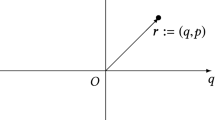Abstract
We explore the possibilities of a new informal language, applicable to the microdomain, which enables such characteristics as superposition and discreteness to be introduced without recourse to the quantum algorithm. In terms of new notions that are introduced (e.g. ‘potentiation’ and ‘ensemblation’), we show that an experiment need no longer be thought of as a procedure designed to investigate a property of a ‘separately existing system’. Thus, the necessity of a sharp separation between the ‘system under observation’ and the ‘apparatus’ is avoided. Although the new language is very different from that of classical physics, classical notions appear as a special limiting case.
This new informal language leads to a mathematical formalism which employs the descriptive terms of a cohomology theory with values in the integers. Thus our theory is not based on the use of a space-time description, continuous or otherwise. In the appropriate limit, the mathematical formalism contains certain features similar to those of classical field theories. It is therefore suggested that all the field equations of physics can be re-expressed in terms of our theory in a way that is independent of their spacetime description. This point is illustrated by Maxwell's equations, which are understood in terms of cohomology on a discrete complex. In this description, the electromagnetic four-vector potential and the four-current can be discussed in terms of an ‘ensemblation’ of discontinuous hypersurfaces or varieties. Since the cohomology is defined on the integers the charge is naturally discrete.
Similar content being viewed by others
References
Atkinson, D. and Halpern, M. B. (1967).Journal of Mathematical Physics,6, 373.
Bohm, D. (1960).Quantum Theory. Prentice-Hall, New Jersey.
Bohm, D. (1965a).The Special Theory of Relativity. Benjamin, N.Y.
Bohm, D. (1965b).The Special Theory of Relativity Appendix. Benjamin, N.Y.
Bohm, D. (1968).Contemporary Physics, Vol. II, 439 Trieste Symposium (London).
Bohr, N. (1934).Atomic Theory and the Description of Nature. Cambridge (reprinted 1961).
Bohr, N. (1958).Atomic Physics and Human Knowledge. Wiley (New York).
Cairns, S. S. (1961).Introductory Topology. Ronald Press, New York.
Hiley, B. J. (1968).Quantum Theory and Beyond. Cambridge.
Hill, E. L. (1955).Physical Review,100, 1780.
Hilton, P. J. and Wylie, S. (1960).Homology Theory. Cambridge.
Misner, C. W. and Wheeler, J. A. (1957).Annals of Physics,2, 525.
Schild, A. (1949).Canadian Journal of Mathematics,1, 29.
Snyder, H. S. (1947).Physical Review,71, 38.
Author information
Authors and Affiliations
Rights and permissions
About this article
Cite this article
Bohm, D., Hiley, B.J. & Stuart, A.E.G. On a new mode of description in physics. Int J Theor Phys 3, 171–183 (1970). https://doi.org/10.1007/BF00671000
Received:
Issue Date:
DOI: https://doi.org/10.1007/BF00671000



